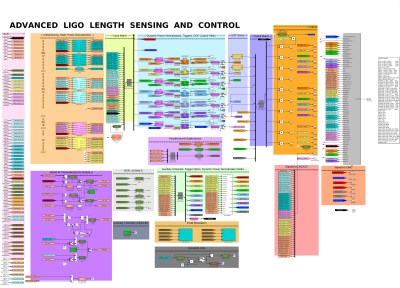The Laser Interferometer Gravitational-Wave Observatory (LIGO) is a huge installation measured in kilometers that is listening for wrinkles in space-time. Pulling this off is a true story of hardware and software hacking, and we were lucky to have Dr. Keith Thorne dive into those details with his newly published “Extreme Instruments for Extreme Astrophysics” keynote from the 2021 Hackaday Remoticon.
Gravity causes space-time to stretch — think back to the diagrams you’ve seen of a massive orb (a star or planet) sitting on a plane with grid lines drawn on it, the fabric of that plane being stretch downward from the mass of the orb. If you have two massive entities like black holes orbiting each other, they give off gravitational waves. When they collide and merge, they create a brief but very strong train of waves. Evidence of these events are what LIGO is looking for.
 Rai Weiss had the idea to look for gravitational waves using laser interferometers in about 1967, but the available laser technology was too new to accomplish the feat. In an interferometer, a laser is shot through a beam splitter and one beam reflects out and back over a distance, and is then recombined with the other half using a photodetector to measure the intensity of light. As the distance in the long leg changes, the relative phase of the lasers shift, and the power detected will vary.
Rai Weiss had the idea to look for gravitational waves using laser interferometers in about 1967, but the available laser technology was too new to accomplish the feat. In an interferometer, a laser is shot through a beam splitter and one beam reflects out and back over a distance, and is then recombined with the other half using a photodetector to measure the intensity of light. As the distance in the long leg changes, the relative phase of the lasers shift, and the power detected will vary.
LIGO is not your desktop interferometer. It uses a 5 kW laser input. The 4 km legs of the interferometer bounce the light back and forth 1,000 times for an effective 4,000 km travel distance. These legs are kept under extreme vacuum and the mirrors are held exceptionally still. It’s worth it; the instrument can measure at a precision of 1/10,000 the diameter of a proton!
The Hacks That Make LIGO Possible
Keith says “There’s no ACME Interferometer Company you can order things from”. This is something that’s often overlooked: doing hard science usually means bringing new instruments into existence. While the topic of laser interferometery existed long before LIGO began, the precision of it has never before been seen in anything humans have built.
The team is using off-the-shelf computers, but traditional operating systems lack the real-time access needed for quickly reading the photodetector values. The hack was to leverage multicore CPUs but dedicate a single core to making the readings. This was done via custom work with the Linux kernel.

Once you have a system like this, innumerable researchers will want to use it to conduct their own research. The team knew that many of these scientists were already using MATLAB. The LIGO user-interface hack was to write a MATLAB Simulink plugin that configures the system. Now researchers can use that graphical interface to control the hardware directly during their time on the machine.
Much troubleshooting was done to eliminate noise from the electronic control systems. One neat detail was that they utilized a dual-tone oscillator setup (960 Hz and 961 Hz) to produce a 1-pulse-per-second timing system. But there are further juicy details like needing to remove LED status lights near the digitizer as they were injecting interference when they blinked.
The mechanical engineering hacks are pretty bonkers. The laser beam is so powerful, that a physical barrier is necessary to protect from it burning through delicate equipment. They built a high-speed physical shutter that can slam into place in the beam path and make sure you don’t fry your equipment.
An Inside Look at Absolutely Incredible Equipment
We’re so thankful to Keith for presenting this talk at Remoticon. LIGO is at the cutting edge of astrophysics, and even the geekiest of us only have a rudimentary knowledge of the work being done. His thoughtful presentation embedded below is a pleasure to watch, and we hope it helps us open our eyes to all of the interesting work, and tremendously clever hacks, that go on every day in the name of science.
















Thanks for posting this, it’s always nice to have a little peak behind the proverbial curtain. I wonder if this hack for better time resolution will find uses in robotics. I wonder if their forecast for a trading crash will come to fruition.
Michelson-Morley on steroids. They will discover that aether is real.
It’s funny how some folks are completely misinformed on aether. Probably because science hides how aether was studied by the MMX. The truth is Michelson and Morley got a null signal due to the Earth’s magnetic field, not because aether was actually disproven; yes, they were using interferometers before the 1900’s and yes, the science community buried the theory 30 years after their invalid research.
Then Einstein quantified the severing of aether by splitting it into space-time and e=mc2, but this has led science astray from the study that it’s both one thing.
Aether is both gravitational waves and electromagnetic fluid-like dynamics. It’s like light shafts in water, the water has a medium to hold spinning mass, while light can penetrate the medium and only be partially affected by the weaker gravity. Maxwell being incorrect in his idea of rubbery or rigid aether.
But what gets missed is how particles form.
We know nuclear explosions create new and different particles and new studies are creating particles from thin air. If we look at aether, it’s “speed limit” or friction, is C or the speed of light.
Due to this friction in the medium, higher than gamma EM oscillations start to create a magnetic fold and take form, like sand on a plate in cymatics. The different intervals of these high gamma EM oscillations create 3D patterns of “pockets” of charge; which is sorta how the standard model element chart is formed.
These “pockets” of charge in an atom can have stability or decay, exchange charge, emit radiation (helium) or can attract other atoms.
What’s also fun is that this idea of aether also supports other types of EM exchange, like brainwaves (TMS, EEG, etc), magnetic “fields” and others. But aether then “fills in the blank” when it comes to dark energy/matter, since the “fluid-like” medium of aether (which fills the universe) can explain why gravity can warp EM propagation, but also why spinning mass can attract smaller bodies.
Aether wasn’t just pulled out of Newton’s proverbial ass either, this was information he compiled and co-researched (with other scientists) his discoveries in the Emerald Tablets (which he translated, btw).
All this is historically valid as well, look it up.
Since this understanding of the universe was based on a book, supposedly derived from technology from Atlantis, it’s probably worth investigating. Since, if there was a culture (most likely in the Richat Structure) that could’ve had knowledge of the universe, which obliterated themselves, then maaaaybe we should at least keep checking out what that understanding actually meant.
It unfortunately does make sense for aether to go underground, since the type of weapons (similar to military microwave crowd dispersion weapons or voice of God tech) you could make, with this understanding, could be damaging. Or flying saucers, since aether explains how applying pressure to the “liquid” of aether (not just the EM aspect) in 180 degrees, can create lift… and then allow some to mine the asteroid field or worse, push an asteroid at Earth.
Many more examples like this, but obviously, we need to study in that direction, since SCIENCE IS BROKEN FOLKS!!! It will remain broken with this particle field bs, since it’s only studying part of this medium.
I’ll add this fun quip, since you probably think I watch too much YouTube or something already, but… Einstein is the most relatable to the anti-christ! There, I said it. This aetheist ideology that fronts as science and literally has 90% of CERN experiments fail, is what is governing society!
We literally are pushing out God for some white coat lab regurgitator to continue to mention “we may never know, but this sorta works, so why change it?”, before every talk about physics. Why do we need that as our primary scientific approach, when aether is still a valid possibility?
Also, yes, if you spin an interferometer vertically, you can measure the Earth’s magnetic field. We know the field is there, it literally stops x-rays and makes the Aurora Borealis. This invalidates the MMX experiment (on Earth anyway) and proves aether is still a possibility.
These sensors have to be able to measure such small variations in distance. It really is amazing they can do that and makes me happy to live in this time period.
Why are you using my handle?
(The real Ren)
Bummer. Misread the title (no glasses..) and was looking forward to Extreme Engineering with LEGO!
I can’t believe that such an awesome HaD article has garnered so few comments. I’m guessing that they didn’t use enough Arduinos. Anyway, I thoroughly enjoyed the video and the hacks involved. I’m wondering which variants of RT Linux patches they have tried. The level of measurement precision that they have attained is truly astonishing.
Very gravitating…
Keith is a friend, and has been regaling us about LIGO at (pre-pandemic) parties for years! It’s great to see his expertise and humor emerge through another medium.
Just curious? Have heard of Fpga’s???? They must? (Thinking out loud, they must of stuck with the system that they started with). I am very curious why they did not go this route!! Thanks Mikek
I was fully convinced with dr. Keith Thorne’s keynote, but at 48:48 in the video he gave himself away: “[…] you are not on a flat earth […]”. I buy accuracy of 1/10.000 th of the size of o pronton, but don’t start with the round earth theory…
Well, it is difficult to prove the Earth is flat.
To do so, we would need to find 2 other large flat surfaces and rub them alternately together with Prussian Blue to show if any areas are non-flat.
If Dr. Keith Thorne is still answering questions:
I noted from the talk that the vacuum they are pulling is higher than ‘space’ and by that he probably means inside the solar system.
So does this preclude a space-based LIGO? What would happen if they operated terrestrial LIGO at mere ‘space’ vacuum – would there be scattering of the light for example, and degradation of performance?
I thought there was a LIGO satellite.
Look up LISA, space-based gravitational wave detectors are planned, although still about 2 decades out.
Has LISA produced any results yet? Or is it early days?
It has not even launched.
I am waiting for the hackaday article on a device that uses a neural network and a camera to assess the crankiness of text. Something handheld with a nice analog meter and maybe an alarm setting so that I can go through this comments section without getting drawn into flat eartherism and crank physics discussion.